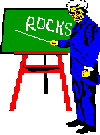
Homework and Laboratory Exercises
One of the easiest ways to begin is to put your favorite classroom or homework exercises on the Internet. Often, such exercises can standalone and, as such, can be of some utility to other instructors or students. A few examples follow along with a link to a catalog of laboratory exercises. Many of the exercises that follow are not "interactive". They are included to give the readers ideas for the development of their own exercises.
If you would like to have your students use these (or other Internet-based) exercises, please contact the developer. Most are quite willing but turning your 200 students loose on a resources could overload a small server.
- Building Stones of Toronto
"WALKING TOUR TO STUDY SOME OF THE BUILDING STONES USED IN TORONTO
Most building stones in Toronto are of igneous or sedimentary origin, but metamorphic rocks are also represented. Intrusive
igneous rocks have a coarse inter-locking texture; they are durable and polish well. Sedimentary rocks are generally softer and
more porous; they are commonly used for ornamental purposes such as carved entablatures over doorways or fluted columns.
Metamorphic rocks are represented by a variety of marbles and gneisses, and are generally used as polished facing stones on
interior and exterior walls." This is an exercise which could be adapted to the area around your university.
- Discovering Plate Boundaries
"A classroom exercise designed to allow students to discover the properties of tectonic plates and their
boundaries. "Discovering Plate Boundaries" has been used with students from Eighth Grade to Undergraduates
at Rice University."
- Dangerous Earth
Five exercises - earthquakes, volcanoes, caves and sinkholes, tsunami, and an introduction to geology.
- Earth Science OnLine Tutorial Center
From Cerritos College, California. Interactive tutorials for topographic maps, earth processes, and more.
- Earthquake Laboratory
"A minor earthquake (magnitude 3.6) occurred in northern California during the afternoon of March 15, 1985.
Short-period seismographs from 3 stations (DBM, SRM, WGL) in northern California recorded this event. Portions of the seismic records from each of these 6 stations are given below. Vertical lines on the seismograms represent 2 second intervals (1 cm = 2 secs). In general there was little seismic activity prior to this earthquake, so that the seismograph at each station was quiet before the first arrival from this earthquake. "
- Homework Exercises for Environmental Geology
Tulane University. Disasters, Seismology, Volcanoes, Mass Wasting, Flooding and Weather.
- Interactive Models for Geologic Education
"Welcome! This site provides interactive computer models to aid in undergraduate geological
education.
Please feel free to browse and download our products. These interactive models were created for the
Macintosh, and have been saved as Binhexed archives. You may need the SuperCard╣ Player 3.0.1
to use some of the models. Here are some highlights:"
- Flooding Exercise
University of Cincinnati. "A flood is usually caused by a stream that has overflowed its banks during periods of high runoff. Floods occur when
the water height or stage of a stream, commonly measured by a stream guage, passes some predetermined level, which
is usually taken as the bank-full stage. When the stream channel can no longer accommodate the increased discharge it
overflows its banks. This exercise is designed to explore the nature of floods and flood prediction. "
- Interpreting Earth History
"
With a cross section view we can begin to apply our geological principles -- superposition, original horizontality, cross-cutting
relationships, ... -- and begin to work out the sequence of events that produced the materials beneath the surface. Look at the cross section
given above and, when you are ready, take a short quiz to see how well you can decipher Earth history.
"
- Landslides
University of Cincinnati. " Landslides and mass movements involve the downslope movement of rock and/or soil and other surficial
materials under the influence of gravity. Movement in landslides is generally rapid and takes place such
that the center of gravity moves in a downward and outward direction. In this example, water-saturated
bedrock and regolith fail along a curved surface and produce a landslide."
- Oceanography Laboratories
California State University @ San Jose."Sea water covers 71% of the earth's surface or 360 million square kilometers and
composes 97% of the earth's water thus making our planet a unique body within our
solar system. Several bodies in our solar system may have sheets of ice and one
moon of Jupiter may have an ocean, but the extent and amount of sea water on earth
is special.
- Physical Geology Lab
from Texas A&M University. Power Point presentations covering the background needed for a Physical Geology laboratory course. This is a good resource for Teaching Assistants as well as for the students themselves
- Subduction Zone Exercise
Columbia University -- Study the relationship between bathymetry, volcanoes and earthquakes for a subduction zone."
- Topographic Maps
Clavert College. "Two
exercises are
included on
this map, and
this screen
will serve as
an index to
the
individual
exercises. The
lower box
provides a
link to an
exercise on
scale reading.
The middle
box leads to
exercise in
reading
contour lines.
And the
upper box
represents an
exercise on
flood-plain
analysis that
is still in the
works".
- Thematic Maps
Occidental College. "From this page, you can access various thematic maps covering parts of Los Angeles County. These GIF images are
derived from graphics created in COREL Draw by Prof. Scott Bogue (Geology, Occidental College). They are all based on
maps originally compiled and drafted by Prof. James Sadd."
- The Image Tasks Exercises
From the Visualizing Earth Project at UCSD.
- Volcano Project
the University of Houston. These exercises are a mix of data gathering, data analysis, and data synthesis.
There are more than 125 homework and laboratory exercises in the FileMaker Pro Database
January 15, 2001
Return to the Virtual Geosciences Professor's Good Practices Home Page
